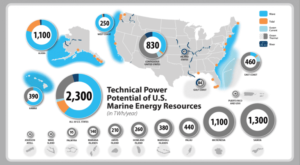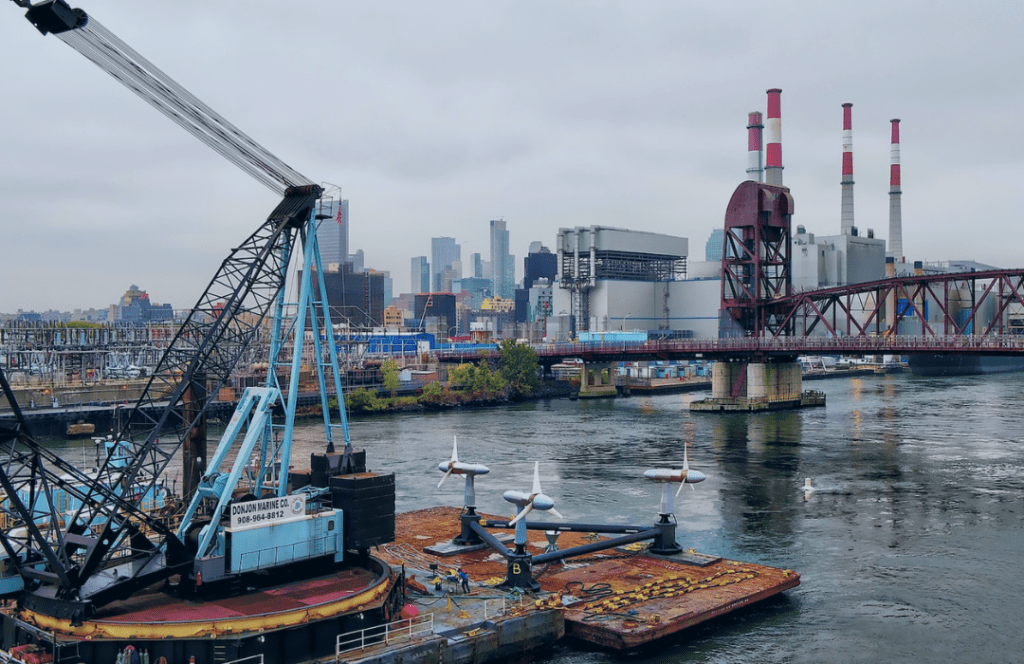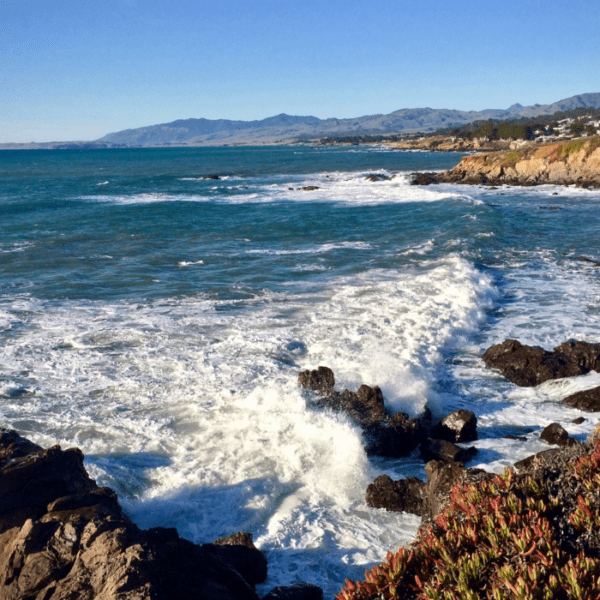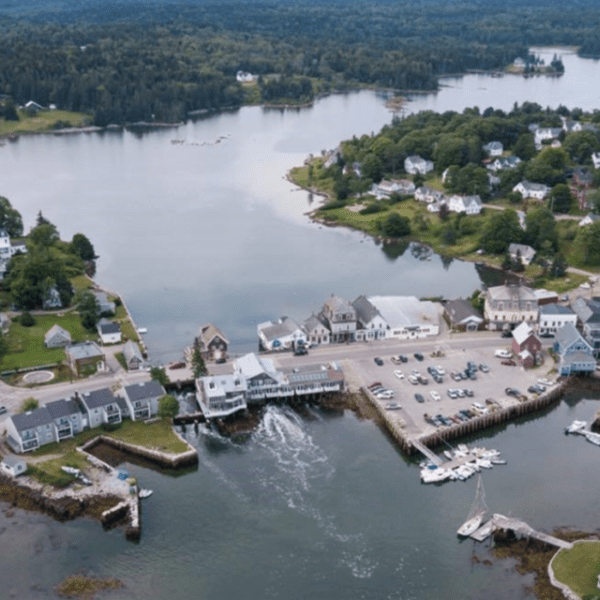In October 2020, the East River in New York City became a laboratory for the next generation of clean energy. As a test demonstration, marine energy developer Verdant Power deployed its Tidal Turbines into the river, and, after only 85 days, had generated 100 megawatt-hours of electricity. This achievement marks another step toward the commercialization of the marine energy industry, but it also represents just a small fraction of the generation potential of marine energy.
Much like solar energy during its nauseant stage of development, marine energy is expected to play a large role in the United States’ shift to a carbon-free electricity grid. But, for years, how much of a role has been up for debate. That is until last week, when the U.S. Department of Energy and the National Renewable Energy Laboratory (NREL) released the Marine Energy in the United States: An Overview of Opportunities — a new report assessing the resource potential of marine energy (wave, tidal, ocean current, ocean thermal, and riverine marine). And the findings are far greater than many have expected.
The analysis demonstrates marine energy resources are large, predictable and geographically diverse, with a potential to contribute significantly to our energy demand if deployed on a utility-scale. The report conservatively estimates the total marine energy technical resource in the 50 states is 2,300 terawatt-hours (TWh) a year, which is equal to 57% of the electricity generated in the U.S. in 2019. This is equivalent to powering 220 million homes.

Why It Matters
Marine energy has the ability to contribute substantially to the U.S.’s clean energy future. In fact, utilizing just 10 percent of the marine energy’s technical resource is equivalent to over three times U.S. solar generation in 2019 and one quarter of the U.S. coal fleet.
Essentially, the report gives the Biden Administration and Congress, both of whom have made climate change their focus, a significant new roadmap for achieving deep decarbonization.
Additionally, the report can serve as a catalyst to help the marine energy industry — a young renewable — to address its biggest challenges of reaching full-scale commercialization, including increasing government funding to further research, development and demonstration and streamlining of the regulatory and permitting process.
Infrastructure upgrades to facilitate these emerging technologies and global standards are necessary to capitalize on marine energy’s potential to make significant contributions to a clean energy future.
Bottom line? Marine energy could be the missing link in President Biden’s ambitious goal of achieving 100 percent clean electricity by 2035.
Deeper Dive
The new report goes beyond just providing a topline number for potential generation. It pinpoints regions where the specific marine energy technologies would be applicable. For example, on the West Coast, wave energy would be the dominant source, where there is a potential for 250 TWh/yr, which is equivalent to 67% of the region’s net electricity generation in 2019, enough to power 23-million homes (9GW of capacity).
The East Coast region’s marine energy technical resource is equivalent to 49% of the region’s 2019 net electricity generation, with the Gulf Stream’s ocean current resource landing at 49 TWh/hr or 4.6 million homes.
Hawaii, through wave and ocean thermal, has a technical resource potential to power 37 million homes or 9.4% of total U.S. states electricity generation produced in 2019.
Alaska’s technical resource comes in at 180 times the state’s electricity generation or 27% of total electricity generation in the U.S. states in 2019. The state represents nearly all (93%) of the country’s highly predictable tidal resource. Cook inlet, located close in proximity to a grid that powers over two-thirds of the state’s residents, has the potential to power 43% of the state’s generation through tidal.
The report provides many granular examples of where marine energy could be impactful.
One worth noting is the contribution marine energy could have in a scenario where wind and solar are contributing more and more of the electric power generation make-up. As these variable renewables play an increasing role in the nation’s energy mix, the predictability of marine energy has the potential to prove particularly valuable.
Aside from energy generation, the resource can also play a major role in workforce development as well as provide supply chain opportunities.
What’s Next for Marine Energy?
There is much to be done for the industry before it can capitalize on the potential outlined in the NREL report.
Testing devices remains front and center for many developers. On March 1, 2021, the Federal Energy Regulatory Commission (FERC) issued a 25-year hydroelectric production license for Oregon State University’s PacWave South testing facility to deploy and test technologies to generate energy from ocean waves. It’s FERC’s first-ever license for a wave energy facility. The ability to test devices in the unforgiving waters of the Pacific Ocean, about 6 nautical miles off the coast of Newport, Oregon, is expected to go a long way in proving the viability of devices.
In an effort to break down barriers to commercialization, NHA is working with the Biden administration. In particular, NHA’s Marine Energy Council (MEC) looks forward to sharing details from its soon-to-be-released “Commercialization Strategy for Marine Energy” with recommendations on how the U.S. can provide leadership in this emerging renewable power sector. By adopting the recommendations, the U.S. can increase economic growth, create thousands of high-value jobs, support the clean energy transition, and promote exports in manufacturing and services.
In addition to Verdant, marine energy technology developer ORPC has deployed a project in Alaska that demonstrates the potential of harnessing river currents to generate electricity. ORPC’s RivGen® Power System proves the positive impact marine energy projects can have on remote communities highly reliant on diesel. In a year, the 35-kW system, installed in the Kvichak River, supplied over 8 megawatt-hours of electricity to the Alaskan Village of Igiugig’s grid. A second RivGen® Power System is set for deployment in the summer of 2021.
Convening a Global Event in April to Focus on Marine Energy
In an effort to highlight early successes with deployments, such as Verdant’s and ORPC’s, and to create a forum for knowledge exchange, the United States is hosting a virtual global conference and trade show next month.
The International Conference on Ocean Energy (ICOE) takes place April 28-30, 2021. NHA is organizing the event in cooperation with the U.S. Department of Energy and Ocean Energy Systems (OES). OES is an intergovernmental technology collaboration program involving the 29 member countries of the International Energy Agency.
“We are bringing global leaders together to share their experiences and knowhow, with the collective goal of advancing the industry,” says Tim Ramsey, program manager for marine and hydrokinetics at the U.S. Department of Energy’s Water Power Technologies Office and U.S. delegate to the OES.
“We are anticipating high-quality presentations and great exchange among academia and industry,” Ramsey said.
All sessions will be recorded, and available to attendees “on demand” for one year after the event.
In addition to the conference sessions and the poster gallery, the ICOE event also features a Virtual Exhibit Hall and sponsored sessions.
More details about the conference program and exhibitors can be found here.
Registration is open. Early bird rates are available until the end of March.












